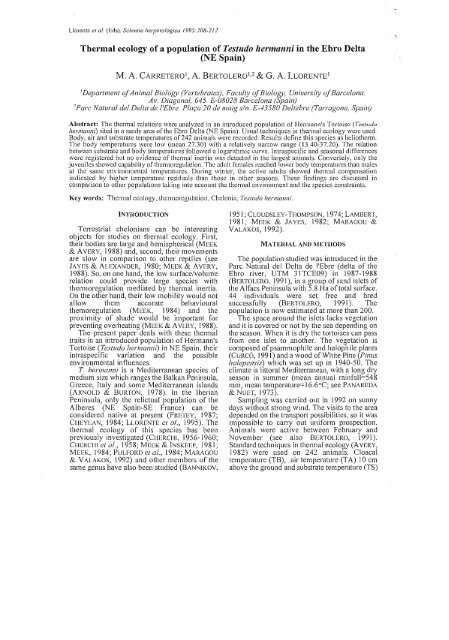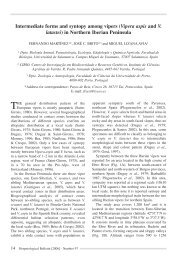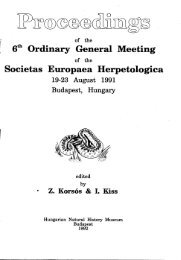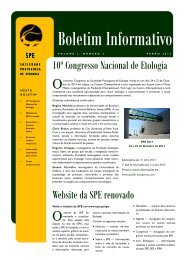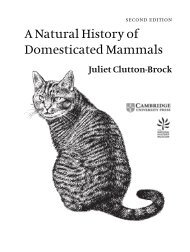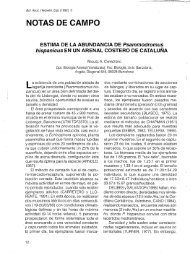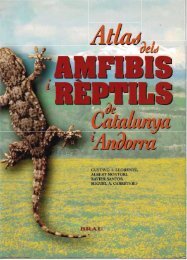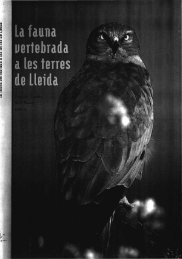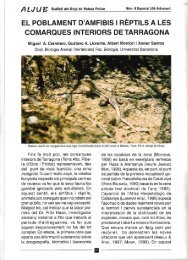Thermal ecology of a population of Testudo hermann; in the Ebro ...
Thermal ecology of a population of Testudo hermann; in the Ebro ...
Thermal ecology of a population of Testudo hermann; in the Ebro ...
You also want an ePaper? Increase the reach of your titles
YUMPU automatically turns print PDFs into web optimized ePapers that Google loves.
Llorente et al. (Eds). Sciemia heljJetologica 1995:208·212<br />
<strong>Thermal</strong> <strong>ecology</strong> <strong>of</strong> a <strong>population</strong> <strong>of</strong> <strong>Testudo</strong> <strong>hermann</strong>; <strong>in</strong> <strong>the</strong> <strong>Ebro</strong> Delta<br />
(NE Spa<strong>in</strong>)<br />
M. A CARRETER0 1 , A. BERTOLERO),2 & G. A LLORENTE)<br />
I Department q(Animal Biology (Vertebrates), Faculty <strong>of</strong>Biology, University <strong>of</strong>Barcelona.<br />
Av. Diagonal, 645. £-08028 Barcelona (Spa<strong>in</strong>)<br />
]Parc Natural del Delta de /'£bre. P/m;:a 20 de maig s<strong>in</strong>. £-43580 Deltebre (Tarragona, Spa<strong>in</strong>)<br />
Abstract: The <strong>the</strong>rmal relations were analyzed <strong>in</strong> an <strong>in</strong>troduced <strong>population</strong> <strong>of</strong> Hermann's Tortoise (Tesludo<br />
<strong>hermann</strong>i) sited <strong>in</strong> a sandy area <strong>of</strong> <strong>the</strong> <strong>Ebro</strong> Delta (NE Spa<strong>in</strong>). Usual techniques <strong>in</strong> <strong>the</strong>rmal <strong>ecology</strong> were used.<br />
Body, air and substrate temperatures 01'242 animals were recorded. Results def<strong>in</strong>e this species as helio<strong>the</strong>rm.<br />
The body temperatures were low (mean 27.30) with a relatively narrow range (13.40·37.20). The relation<br />
between substrate and body temperatures followed a logarithmic curve. Intraspecific and seasonal differences<br />
were registered but no evidence <strong>of</strong> <strong>the</strong>rmal <strong>in</strong>ertia was detected <strong>in</strong> <strong>the</strong> largest animals. Conversely, only <strong>the</strong><br />
juveniles showed capability <strong>of</strong> <strong>the</strong>rmoregulation. The adult females reached lower body temperatures than males<br />
at <strong>the</strong> same environmental temp·eratures. Dur<strong>in</strong>g w<strong>in</strong>ter, <strong>the</strong> active adults showed <strong>the</strong>rmal compensation<br />
<strong>in</strong>dicated by higher temperature residuals than those <strong>in</strong> o<strong>the</strong>r seasons. These f<strong>in</strong>d<strong>in</strong>gs are discussed <strong>in</strong><br />
comparison to o<strong>the</strong>r <strong>population</strong>s tak<strong>in</strong>g <strong>in</strong>to account <strong>the</strong> <strong>the</strong>rmal environment and <strong>the</strong> species constra<strong>in</strong>ts.<br />
Key wOI'ds: <strong>Thermal</strong> <strong>ecology</strong>, <strong>the</strong>rmoregulation, Chelonia, Tesilldo hermanlli.<br />
INTRODUCTION 1951; CLOUDSLEY-THOMPSON, 1974; LAMBERT,<br />
1981; MEEK & JAYES, 1982; MARAGOU &<br />
Terrestrial chelonians can be <strong>in</strong>terest<strong>in</strong>g VALAKOS, 1992).<br />
objects for studies on <strong>the</strong>rmal <strong>ecology</strong>. First,<br />
<strong>the</strong>ir bodies are large and hemispherical (MEEK MATERIAL AND METHODS<br />
& AVERY, 1988) and, second, <strong>the</strong>ir movements<br />
are slow <strong>in</strong> comparison to o<strong>the</strong>r reptiles (see The <strong>population</strong> studied was <strong>in</strong>troduced <strong>in</strong> <strong>the</strong><br />
JAYES & ALEXANDER, 1980; MEEK & AVERY, Pare Natural del Delta de I'Ebre (delta <strong>of</strong> <strong>the</strong><br />
\988). So, on one hand, <strong>the</strong> low surface/volume <strong>Ebro</strong> river, UTM 3lTCE09) <strong>in</strong> 1987-1988<br />
relation could provide large species with (BERTOLERO, 1991), <strong>in</strong> a group <strong>of</strong> sand islets <strong>of</strong><br />
<strong>the</strong>rmoregulation mediated by <strong>the</strong>rmal <strong>in</strong>ertia. <strong>the</strong> Alfacs Pen<strong>in</strong>sula with 5.8 Ha <strong>of</strong>tota! surface.<br />
On <strong>the</strong> o<strong>the</strong>r hand, <strong>the</strong>ir low mobility would not 44 <strong>in</strong>dividuals were set free and bred<br />
allow <strong>the</strong>m accurate behavioural successfully (BERTOLERO, 1991). The<br />
<strong>the</strong>moregulation (MEEK, 1984) and <strong>the</strong> <strong>population</strong> is now estimated at more than 200.<br />
proximity <strong>of</strong> shade would be important for The space around <strong>the</strong> islets lacks vegetation<br />
prevent<strong>in</strong>g overheat<strong>in</strong>g (MEEK & AVERY, 1988). and it is covered or not by <strong>the</strong> sea depend<strong>in</strong>g on<br />
The present paper deals with <strong>the</strong>se <strong>the</strong>rmal <strong>the</strong> season. When it is dry <strong>the</strong> tortoises can pass<br />
traits <strong>in</strong> an <strong>in</strong>troduced <strong>population</strong> <strong>of</strong> Hermann's from one islet to ano<strong>the</strong>r. The vegetation is<br />
Tortoise (<strong>Testudo</strong> he/,l11anni) <strong>in</strong> NE Spa<strong>in</strong>, <strong>the</strong>ir composed <strong>of</strong>psammophile and halophile plants<br />
<strong>in</strong>traspecific variation and <strong>the</strong> possible (CUReD, ]991) and a wood <strong>of</strong> White P<strong>in</strong>e (P<strong>in</strong>us<br />
environmental <strong>in</strong>fluences. halepensis) which was set up <strong>in</strong> 1940-50. The<br />
T. herma/1ni is a Mediterranean species <strong>of</strong> climate is littoral Mediterranean, with a long dry<br />
medium size which ranges <strong>the</strong> Balkan Pen<strong>in</strong>sula, season <strong>in</strong> summer (mean annual ra<strong>in</strong>fall=548<br />
Greece, Haly and some Mediterranean islands 111111, mean temperature=16.6°C; see PANAREDA<br />
(ARNOLD & BURTON, 1978). In <strong>the</strong> Iberian & Nun, 1973).<br />
Pen<strong>in</strong>sula, only <strong>the</strong> relictual <strong>population</strong> <strong>of</strong> <strong>the</strong> Sampl<strong>in</strong>g was carried out <strong>in</strong> 1992 on sunny<br />
Alberes (NE Spa<strong>in</strong>-SE France) can be days without strong w<strong>in</strong>d. The visits to <strong>the</strong> area<br />
considered native at present (FRETEY, 1987; depended on <strong>the</strong> transport possibilities, so it was<br />
CIIEYLAN, 1984; LLORENTE et al., 1995). The impossible to carry out uniform prospection.<br />
<strong>the</strong>rmal <strong>ecology</strong> <strong>of</strong> this species has been Animals were active between February and<br />
previously <strong>in</strong>vestigated (CHERClll, 1956-1960; November (see also BERTOLERO, 1991).<br />
CHERCHI el al., 1958; MEEK & INSKEEP, 1981; Standard techniques <strong>in</strong> <strong>the</strong>rmal <strong>ecology</strong> (AVERY,<br />
MEEK, 1984; PULFORD et al., 1984; MARAGOU 1982) were used on 242 animals. Cloacal<br />
& V ALAKOS, 1992) and o<strong>the</strong>r members <strong>of</strong> <strong>the</strong> temperature (TB), air temperature (TA) 10 cm<br />
same genus have also been studied (BANNIKOV, above <strong>the</strong> ground and substrate temperature (TS)<br />
. '.
212<br />
TeSludo <strong>hermann</strong>; en el Parque Natural del<br />
Delta del <strong>Ebro</strong>. BUll/. Parco Nat. Delta de<br />
l'Ebre, 6: 22-25.<br />
CHELAZZI, G. & CALZOLAl, R. (1986): <strong>Thermal</strong><br />
benefits from familiarity with <strong>the</strong><br />
environment <strong>in</strong> a reptile. Oecologia, 68: 557<br />
558.<br />
CHERCHI, M. (1956): Thermoregolzione <strong>in</strong><br />
<strong>Testudo</strong> <strong>hermann</strong>; Gmel<strong>in</strong>. Bollel;no Muse;<br />
<strong>in</strong>stiluti BiologiC; Un;versita Genova, 28: 5<br />
46.<br />
CHERCHl, M. (1960): Ulteriori richerche sulla<br />
<strong>the</strong>rmoregolazione <strong>in</strong> <strong>Testudo</strong> <strong>hermann</strong>i<br />
Gmel<strong>in</strong>. Bollet<strong>in</strong>o Musei <strong>in</strong>still/ti Biologici<br />
Universita Genova, 30: 35-60.<br />
CHERCHI, M.; HOLZER, R. SORTECCJ, V. &<br />
SERRATO, G. (1958): Microvariazzione di<br />
temperatura <strong>in</strong> Tesludo <strong>hermann</strong>i Gmel<strong>in</strong>.<br />
Bollet<strong>in</strong>o Musei <strong>in</strong>stituti Biologici Universita<br />
Genova, 28: 9-77.<br />
CIIEYLAN, M. (1984): True status and future <strong>of</strong><br />
Hermann's Tortoise <strong>Testudo</strong> <strong>hermann</strong>i<br />
roberlmertensi Wel1muth 1952 <strong>in</strong> Western<br />
Europe. Amphibia-Reptilia, 5( I): 17-26.<br />
CLOUDSLEY-THOMPSON, J. L. (1974):<br />
Physiological <strong>the</strong>rmoregulation <strong>in</strong> <strong>the</strong> spurred<br />
tortoise (<strong>Testudo</strong> graeca L.). Journal ol<br />
Natural History, 8: 577-587.<br />
CLOUDS LEY-THOMPSON, J. L. (1991):<br />
Ecophysiology <strong>of</strong> Desert Arthropods and<br />
Reptiles. Spr<strong>in</strong>ger Ver/ag. Berl<strong>in</strong>. 203pp.<br />
CURCD, T. (1990): La vegetaci6 del Delta de<br />
l'Ebre (I): Les comunitats dunars (Classe<br />
Ammophiletea Br.BI. & Tx. 1943). But//.<br />
Parco Nat. Delta de I'Ebre, 5: 9-18.<br />
FRETEY, J. (1987): Guide des Reptiles de<br />
France. Hatier, Paris. 255pp.<br />
HAILEY, A.; PULFORD, E. A. & STUBBS, D.<br />
(1984): Summer Activity Patterns <strong>of</strong> <strong>Testudo</strong><br />
<strong>hermann</strong>i Gmel<strong>in</strong> <strong>in</strong> Greece and France.<br />
Amphibia-Reptilia, 5: 69-78.<br />
HUEY, R. B. & SLATKIN, M. (1976): Costs and<br />
benefits <strong>of</strong>lizard <strong>the</strong>rmoregulation. Quater!y<br />
Rev. BioI., 51: 363-384.<br />
JA YES, A. S. & ALEXANDER, R. M. (I980): The<br />
gaits <strong>of</strong> chelonians: walk<strong>in</strong>g techniques for<br />
very low speeds. Journal <strong>of</strong>Zoology. London,<br />
191: 353-378.<br />
MEEK, R. & INSKEEP, R. (1981): Aspects <strong>of</strong><strong>the</strong><br />
field biology <strong>of</strong> a <strong>population</strong> Hermann's<br />
Tortoise (<strong>Testudo</strong> <strong>hermann</strong>i) <strong>in</strong> Sou<strong>the</strong>rn<br />
Yugoslavia. British Journal CJl Herpetology,<br />
6: 159-164.<br />
LAMBERT, M. R. K. (1981): Temperature,<br />
activity and field sight<strong>in</strong>g <strong>in</strong> <strong>the</strong><br />
Mediterranean spur-thighed or common<br />
garden tortoise Testlldo graeca. Biological<br />
Conservation, 21: 39-54.<br />
LLORENTE, G. A.; MONTORI, A; SANTOS, X. &<br />
CARRETERO, M. A. (1995): Atlas dels amfibis<br />
i replils de Calalul1ya i Andorra. Ed. EI Brau,<br />
Figueres.<br />
MARAGOU, P. & VALAKOS, E. (1992):<br />
Contribution to <strong>the</strong> <strong>the</strong>rmal <strong>ecology</strong> <strong>of</strong><br />
<strong>Testudo</strong> marg<strong>in</strong>ata and T <strong>hermann</strong>i<br />
(Chelonia: Testud<strong>in</strong>idae) <strong>in</strong> semi-captivity.<br />
Herpetological Journal, 2: 48-50.<br />
MEEK, R. (1984): Thermoregulatory behaviour<br />
<strong>in</strong> a <strong>population</strong> <strong>of</strong> Hermann's TOl1oise<br />
(<strong>Testudo</strong> <strong>hermann</strong> i) <strong>in</strong> Sou<strong>the</strong>rn Yugoslavia.<br />
British Journal oIHerpetology, 6:,387-391.<br />
MEEK, R. & AVERY, R. A. (1988): M<strong>in</strong>i-Review:<br />
Thermoregulation <strong>in</strong> ch,elonians.<br />
Herpetological JOllrnal, 1: 253-259.<br />
MEEK, R. & JAYES, A. S. (1982): Body<br />
temperatures and activity patterns <strong>of</strong> <strong>Testudo</strong><br />
graeca <strong>in</strong> North West Africa. British JOlll'l1al<br />
<strong>of</strong>Herpetology, 6: 194-197.<br />
PANAREDA,1. M. & NUET, J. (1973): EI clima i<br />
les aigUes dels Pa'isos Catalans. pp. 69-\ 02,<br />
<strong>in</strong>: Geogrc-!/ia Fisica dels Paisos Calalans.<br />
Ed. Ketres, Barcelona.<br />
POUGH, F. H. (1980): The advantages <strong>of</strong><br />
ecto<strong>the</strong>rmy for tetrapods. Am. Nat, 115(1):<br />
92-112.<br />
PULFORD, . HAILEY, A. & STUBBS, D. (1984):<br />
<strong>Thermal</strong> relations <strong>of</strong> <strong>Testudo</strong> <strong>hermann</strong>i<br />
robertmertensi Wermuth <strong>in</strong> S. France.<br />
Amphibia-Reptilia, 5: 37-41.<br />
SOKAL, R. R. & ROHLF, F, 1. (1981): BiomellY.<br />
W. H. Freeman and Company, San Francisco.<br />
776 pp.<br />
STEVENSON, R. D. (1985): Body size and limits<br />
to <strong>the</strong> daily range <strong>of</strong> body temperature <strong>in</strong><br />
terrestrial ecto<strong>the</strong>rms. Am. Nat., 125( I): 102<br />
117.


